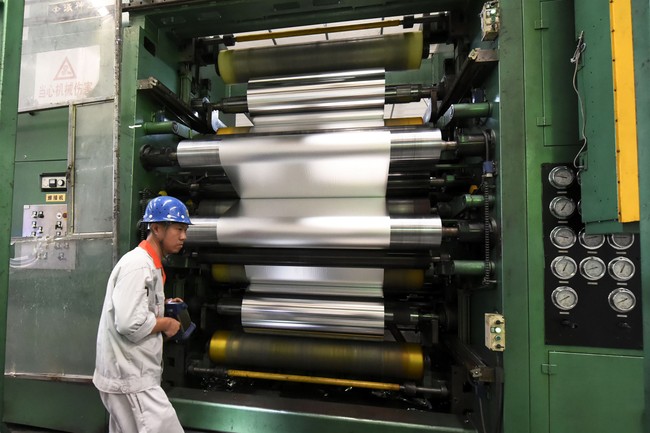
The trade war with China has sent US stocks on a rollercoaster ride and led to disputes about whether or not China is already discussing a trade deal. But the impact is also being felt in China. Last week there a report showed Chinese factories were slowing down in response to tariffs. Estimates of China’s annual growth are already being cut sharply.
Three weeks into a trade war that pushed import tariffs on Chinese-made goods to 145 percent, an official report on manufacturing activity signaled that in April, Chinese factories experienced the sharpest monthly slowdown in more than a year.
Zichun Huang, China economist at Capital Economics, said in a note to clients that the data “suggests that China’s economy is coming under pressure as external demand cools.” Steps the government is taking to pump money into the economy are “unlikely to fully offset the drag,” she said. Capital Economics forecasts the Chinese economy will grow 3.5 percent this year, well short of the government’s 5 percent growth target.
In a research report on Tuesday, Nomura Securities said that if Chinese exports to the United States dropped 50 percent, 5.7 million people in China could lose their jobs immediately. That number could grow to 15.8 million workers once the long-term effects rippled through the economy.
For many Chinese businesses, the tariffs have simply cut off the US market entirely.
Liu Miao has sold clothing on Amazon to wholesale buyers in the United States for the past five years. That trade has come to an abrupt stop.
Mr. Liu owns a small factory in Guangzhou, long the center of China’s highly competitive garment industry. He and other factory managers, already dealing with tight profit margins, said last week that the combination of tariffs and President Trump’s new tax on cheap imports had cut deeply into their businesses. Costs along the supply chain are also higher.
The tariffs have made it impossible for Mr. Liu to continue selling on Amazon, where he previously made about $1 on every garment but now just 50 cents. And he felt he could not cut his employees’ pay, Mr. Liu said, as workers at a labor market crowded past his motorbike, which he had parked on the sidewalk with a dress sample draped over the handlebars.
“You can’t sell anything to the United States right now,” Mr. Liu said. “The tariffs are too high.”
To avoid the job losses and collapse of those businesses, China is trying to redirect all of the products no longer being sent to the US back into the domestic market. But Chinese consumers can’t afford to pay the prices those goods sell for in the US.
“The side effect is a ferocious price war among Chinese firms,” said Yingke Zhou, senior China economist at Barclays Bank…
An influx of discounted goods intended for the U.S. market would also erode companies’ profitability, which in turn would weigh on employment, Zhou said. Uncertain job prospects and worries over income stability have already been contributing to weak consumer demand…
“For exporters that were able to charge higher prices from American consumers, selling in China’s domestic market is merely a way to clear unsold inventory and ease short-term cash-flow pressure,” Shen said: “There is little room for profits.”…
“The removal of the de minimis rule and declining cashflow are pushing many small and medium-sized enterprises toward insolvency,” said Wang Dan, China director at political risk consultancy firm Eurasia Group, warning that job losses are mounting in export-reliant regions.
Of course, China has already announce its 5% growth target for this year, just as it did last year. It’s unlikely that the real figures, whatever they turn out to be, will be reflected in the published figures at the end of the year. There is already strong suspicious that China’s growth last year was well below the 5% figure claimed by the government.
Former Chinese premier Li Keqiang famously told the U.S. ambassador in 2007 that GDP data for a Chinese province he governed at the time were “man-made” and therefore unreliable, according to a leaked U.S. diplomatic cable. Instead, he said he kept track of electricity consumption, rail-freight volumes and new bank loans.
Official GDP figures were “for reference only,” he confided to the ambassador, according to the cable. Li died in October 2023.
China’s official GDP growth of 5% in 2024 exactly matched the target the government had set the previous year. Economists privately dismissed the figure, with one telling the Journal it would have been more credible if authorities had released something lower. Retail sales, construction activity and other data painted a considerably weaker picture, they noted…
In December, a prominent Chinese economist at state-owned SDIC Securities, Gao Shanwen, said at a conference in Washington that China’s economic growth “might be around 2%” the past few years, adding, “we do not know the true number of China’s real growth figure.”
All that to say, China’s economy was already struggling much more than the official figures suggest before Trump’s tariffs took effect. To avoid seeing the economy hit bottom, Xi Jinping is probably going to have to seek a deal fairly soon.












